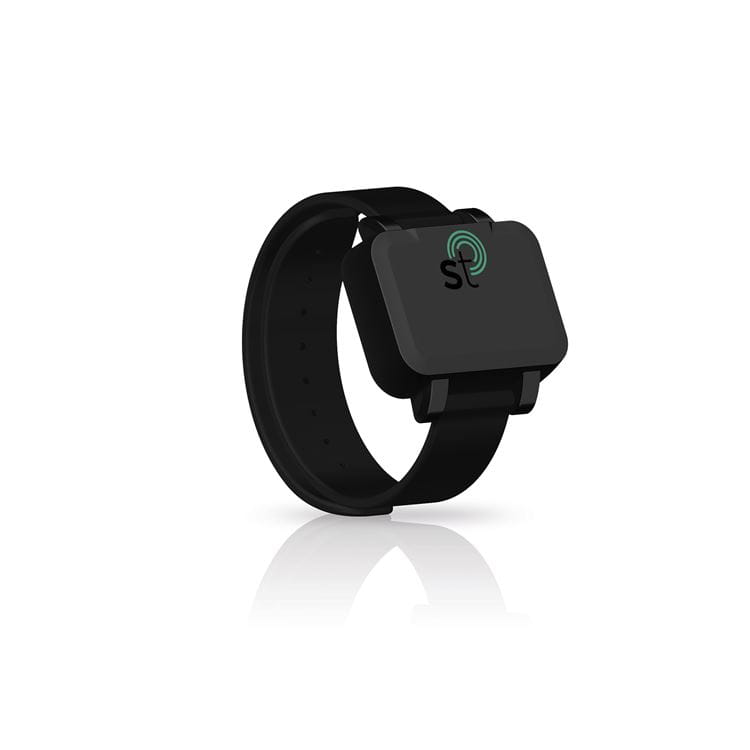Nordic Semiconductor today announces that CareBand, a Chicago, IL-based developer of location-based safety and health solutions, has selected a u-blox ‘NINA B111’ module based on Nordic’s nRF52832 Bluetooth® Low Energy (Bluetooth LE) System-on-Chip (SoC) to provide the short-range wireless connectivity for its ‘SafeTrack’ wearable. The patent-pending SafeTrack is a wrist-worn device designed to support adherence to social distancing protocols as well as enable contact tracing and location monitoring of at-risk populations during the Covid-19 pandemic.
The SafeTrack wearable enables various organizations—including governments and public health departments, schools and universities, companies, manufacturing plants, and senior living facilities—to monitor and manage interactions among groups of people such as children, students, plant workers, and elderly residents. A combination of embedded smart sensors, proprietary algorithms, and the integration of both Nordic SoC-enabled Bluetooth LE connectivity and a smartphone-free Cloud gateway enables reliable wide area data coverage in cases where users may not have access to a paired mobile or where the Wi-Fi/cellular signal is limited.
RSSI proximity monitoring
The CareBand SafeTrack’s u-blox NINA B111 module uses the nRF52832 SoC’s powerful 64MHz, 32-bit Arm® Cortex® M4 processor to run proprietary algorithms and support the wearables built-in accelerometer and other sensors, as well as provide Bluetooth LE connectivity. The nRF52832 SoC also enables SafeTrack to monitor its proximity to other SafeTrack devices (or to other Bluetooth LE-enabled devices and smartphones) using the SoC’s Received Signal Strength Indication (RSSI) feature and machine learning algorithms. The devices can also be configured to vibrate when two wearers are detected within a predetermined distance of each other, reminding users to practice social distancing.
The platform’s contact tracing feature also ensures the wearable continually tracks this proximity data over a period of time. Each SafeTrack stores the identification of other Bluetooth LE devices along with the length of time and average distance of the interaction. The stored interaction data is transmitted from the SafeTrack wearable to the wireless network via a smartphone or Cloud gateway for review using the web-based ‘SafeTrack Management Portal’, or alternatively via the iOS- and Android-compatible ‘SafeTrack Employee App’ on a Bluetooth 4.0 (and later) smartphone, or through an API. The companion app provides user with interaction history, metrics around their social distancing performance and personal risk level, and information on the closest testing locations and when to seek medical attention.
SafeTrack’s location monitoring feature references indoor Bluetooth LE-enabled beacons and outdoor access points. If the wearer goes outside of the network-configured geofence, the wearable sends a notification and alerts the system administrator either through SMS, automated call, email or push notifications via the mobile app or the web-based management portal. This aids monitoring adherence to isolation protocols or in identifying individuals who have left from and returned to a closed community and therefore may be at risk of introducing the virus.
Ultra low power
The CareBand SafeTrack wearable uses a 100mAh battery to achieve approximately five days of battery life depending on the use case and to provide quick wireless recharging, thanks in part to the ultra low power characteristics of the Nordic SoC. The nRF52832 has been engineered to minimize power consumption with features such as the 2.4GHz radio’s 5.5mA peak RX/TX currents and a fully-automatic power management system that reduces power consumption by up to 80 percent compared with Nordic’s nRF51 Series SoCs.
Nordic’s nRF52832 multiprotocol SoC combines the Arm Cortex M4 processor with floating point unit (FPU), with a 2.4GHz multiprotocol radio (supporting Bluetooth 5, ANT™, and proprietary 2.4GHz RF protocol software) featuring -96dB RX sensitivity, with 512kB Flash memory and 64kB RAM. The SoC is supplied with Nordic’s S132 SoftDevice, a Bluetooth 5-certifed RF software protocol stack for building advanced Bluetooth LE applications. The S132 SoftDevice features Central, Peripheral, Broadcaster and Observer Bluetooth LE roles, supports up to twenty connections, and enables concurrent role operation.
“We selected Nordic’s nRF52832 for the SafeTrack wearable due to the compact size and low cost combined with technical features including the ARM CPU capability, large memory capacity, and particularly the low power consumption,” says Adam Sobol, Founder and CEO of CareBand.
“Battery life was a critical consideration as the device is intended to be worn as continuously as possible. In addition, Nordic’s separation of SoftDevice and our own application code, along with the memory-efficient Nordic SDK [Software Development Kit], made developing the application straightforward.
“The Nordic DevZone forum, great field application engineer support, and the availability of a third-party module, the u-blox NINA B111, were also important factors in our decision.”
“Unfortunately contact tracing and social distancing are the new normal, and solutions that help at-risk populations adhere to government guidelines and best practice are essential tools in the fight against Covid-19,” says Geir Langeland, Director of Sales & Marketing, Nordic Semiconductor. “CareBand’s SafeTrack delivers on both counts, and will serve as a helpful and reliable reminder to people to maintain a safe social distance.”

